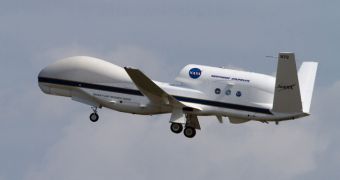Officials at NASA announce that the 2013 Hurricane and Severe Storms Sentinel airborne mission (HS3) was successfully completed recently. This year, the flights were centered on studying the formation and evolution of hurricanes in the Atlantic Ocean.
The main assets for HS3 were two modified Global Hawk unmanned aerial systems (UAS), which NASA has outfitted with a variety of scientific instruments and sensors for airborne research. The aircraft completed their science flights at the end of the hurricane season, this September.
Experts say that the Global Hawk will return for a reiteration of the experiments during the 2014 Atlantic hurricane season. While conducting HS3 flights, the drones were based at the NASA Wallops Flight Facility, on Wallops Island, Virginia, where they first arrived in mid-August.
This year marked the first time when NASA's two drones flew missions from Wallops. Among themselves, the aircraft have already amassed more than 100 flights, which helped scientists gain critical new insight into how tropical storms and hurricanes form and evolve.
“We were able to obtain some excellent data on the Saharan air layer; multiple flights covering the life cycle of Tropical Storm Gabrielle; and an excellent flight for a system in the southern Gulf of Mexico that, despite having a ~70 percent chance of forming, failed to form,” explains scientist Scott Braun.
“However, from a science perspective, it was disappointing because of the low amount of tropical cyclone activity,” adds the expert, who is the principal investigator for the HS3 mission. Braun is based at the NASA Goddard Space Flight Center (GSFC), in Greenbelt, Maryland.
Data on the mysterious Saharan Air Layer (SAL) were captured above the eastern Atlantic Ocean between August 20-21. Around the same time, one of the UAS captured significant information while flying over what was left of Tropical Storm Erin.
Now that HS3 concluded, the two drones have left Wallops, and are already back home, at the NASA Dryden Flight Research Center, located on the US Air Force's Edwards Air Force Base, in California.

 14 DAY TRIAL //
14 DAY TRIAL //